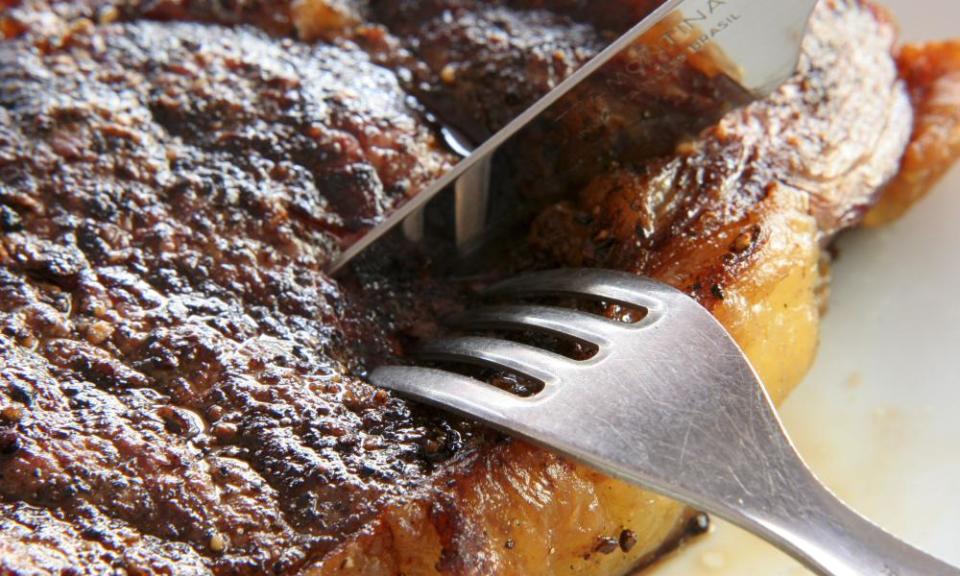High-end steak and chips for a tenner? Welcome to discount dining

From next week Britons will be able to treat themselves to a cut-priced meal in a McDonald’s or a Michelin-starred restaurant as some of the biggest names in food take part in the government’s discount dining scheme.
Just over 53,000 venues, ranging from big high street chains such as McDonald’s and Nando’s to celebrity haunts such as The Ivy, in London’s west end, have signed up to the “eat out to help out” scheme, which aims to get the country’s devastated hospitality industry, where 1.8 million jobs are at stake, back on its feet.
In perhaps a sign of the times, more than 40 Michelin-starred restaurants, including Tom Kerridge’s Hand & Flowers in Marlow, Buckinghamshire, the Kitchin in Edinburgh and Angel at Hetton in Skipton, are taking part in the discount scheme. Many high-end venues have created cheaper dishes tailored to the discount to bring in extra business.
The scheme offers diners 50% off meals eaten in the establishment on a Monday, Tuesday or Wednesday during August with the discount capped at £10 per head. Businesses are then reimbursed by the Treasury with the giveaway expected to cost the taxpayer £500m.
Restaurateurs are hoping the scheme will boost a struggling sector. Hawksmoor, the high-end steak restaurant chain, said it received 5,500 bookings in six hours after it advertised the “best steak and chips in Britain” for a tenner (it reduced the cost of a 300g portion of rump steak and chips from £30 to £20 before applying the discount).
“We’ve pretty much sold all the covers we’ve got available on Monday to Wednesday in August, in our London, Manchester and Edinburgh restaurants,” said Will Beckett, one of the co-owners. “Restaurants traditionally make all of their profit from Thursday to Sunday but that is difficult with social distancing. Almost all restaurants have got some kind of excess capacity on Monday to Wednesday.”
“I’m conscious we are a high-end steak restaurant but I think it is a win-win for everyone. For the industry it is just a free hit. It will be great to have busy restaurants and means more work for staff.”
Related: How will the Eat out to help out scheme work for me?
UKHospitality, the industry trade body, which has been vocal about the existential crisis faced by operators as a result of the pandemic, described the scheme as a potential lifeline.
“The scheme should be a vital lifeline for many businesses, but will only ever be as successful as businesses and customers allow it to be,” said its chief executive, Kate Nicholls. “If we can get more customers out of their homes and back into restaurants, bars and pubs, then certainly it will have been a success.
“Consumer confidence appears to still be low, and we need to show people that they can go out and have a great time safely. If the legacy of the scheme is that people reconnect with hospitality again after months away, then it will be a positive one.”
Britons usually spend around £33bn a year eating out, a figure that swells to £50bn if cash spent at the bar is included. The average amount spent on a meal out in the UK is just over £16 per person giving the discount scheme mainstream appeal.
However, it is estimated that around half of the UK’s 30,900 restaurants are still closed (the 130,000 businesses targeted by the discount dining scheme also includes pubs, bars, in-store cafes and fast food outlets) and there is a question mark as to how many will eventually reopen amid a wave of closures announced by casual dining chains, including Ask Italian, Zizzi and Pizza Express. Some chains have not opened all their sites yet and have been selective in signing up locations to offer the discount.
“Inherently, it’s a good scheme, it will really encourage people to think about eating out,” said Peter Backman, a restaurant industry consultant. “That’s very important.”
The deal might persuade someone who is “gung ho” about eating in restaurants to have additional meals out, potentially with their kids in tow, added Backman. He said: “Then there’s the borderline customer who doesn’t really feel comfortable about eating out but maybe £10 is enough to push them over the line.
“Overall, I think the scheme will add additional business, whether that’s for the longer term or it’s just going to be a blip during August, I don’t know.”
The Rockfish group, which runs eight restaurants in Devon and Dorset, says the deal has set its phones ringing. With its customers spending in the “low 20s” per head, the restaurant is expected to benefit from a rise in demand.
“We’ve had a lot of people calling up and saying what do I need to do and we say the only thing you need to do is book a table,” said restaurant director, Dave Strauss. “We’re fully booked Monday to Wednesday in most of the sites now.
“A family of four are going to come out and have £40 knocked off that bill,” said Strauss. “That’s normally the type of thing restaurants do in January but this is the peak of the summer season and we are going to be full. There is a wave of optimism around something that seems to have no catches.”
With the scheme drawing fire given the government’s new drive to reduce obesity levels, Backman said there are plenty of healthy dishes on menus to choose from with evidence pointing to Britons trying out restaurants they might not normally be able to afford. “It’s not making us go out for burgers at all. It is making us go out and eat in a restaurant.”

 Yahoo Finance
Yahoo Finance 